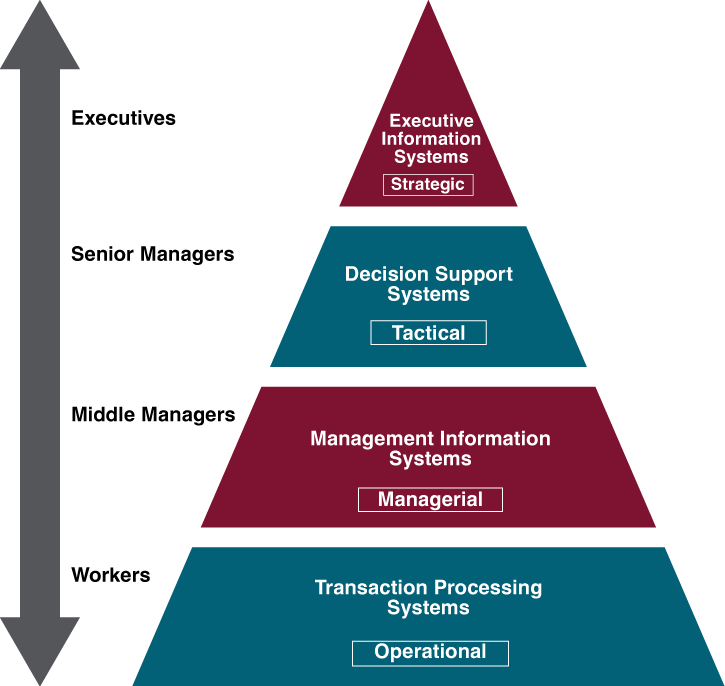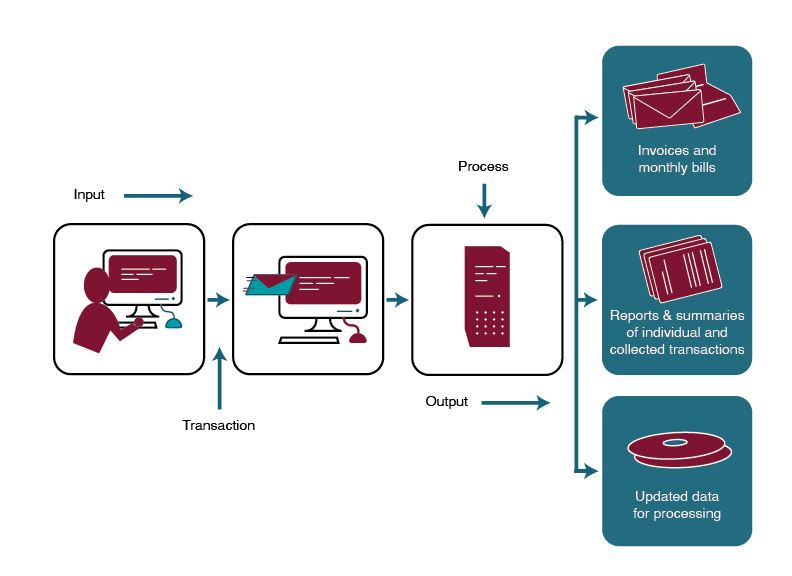11.4. Information Systems
Now that we understand business processes and how to document them, we will explore the different systems businesses use to manage their operations. It is critical that a business understands its own internal processes before purchasing or developing a new system. Sometimes the new system is built to fit the internal processes or sometimes the system dictates how the business operates. To review the systems development process, please see Chapter 7.
There are many different ways in which systems are utilized to automate processes and transactions. Factories use information systems to automate production processes and manage inventory. Banks use a variety of systems to process transactions such as deposits, ATM withdrawals, and loan payments. Information systems are also used to process customer orders and handle billing and vendor payments. Companies typically have several types of information systems, starting with systems to process transactions. Each type of system serves a particular level of decision-making: operational, tactical, and strategic. The image below shows the relationship between transaction processing and management support systems as well as the management levels they serve. Decision support systems will be covered in the next chapter. Let’s take a more detailed look at how companies and managers use transaction processing and management support systems.

Transaction Processing Systems
An integrated information system starts with a Transaction Processing System (TPS). A TPS is a system that collects, modifies and retrieves business transaction data. Every time a consumer uses a point-of-sale system, an ATM, or a service desk, there’s a transaction (some kind of business exchange) occurring, representing an event that’s likely worth tracking. The cash register is the data generation workhorse of most physical retailers, and the primary source that feeds data to the TPS. But while TPS can generate a lot of bits of data, it’s sometimes tough to match this data with a specific customer. For example, if you pay a retailer in cash, you’re likely to remain a mystery to your merchant because your name isn’t attached to your money. Grocers and retailers can tie you to cash transactions if they can convince you to use a loyalty card. Use one of these cards and you’re in effect giving up information about yourself in exchange for some kind of financial incentive. The explosion in retailer cards is directly related to each firm’s desire to learn more about you and to turn you into a more loyal and satisfied customer.
The image below illustrates a transaction processing system in which the transaction is a customer’s electronic payment of a bill. As you can see, transaction processing system output can consist not only of documents sent to outside parties (in this case, notification of payment received), but also of information circulated internally (in the form of reports), as well as of information entered into the database for updating.

The TPS receives raw data from internal and external sources and prepares this data for storage in a database. In fact, all the company’s key data is stored in a single huge database that becomes the company’s central information resource. The database management system tracks the data and allows users to query the database for the information they need. The database can be updated in two ways:
- Batch processing is where data is collected over some time period and processed together. Batch processing uses computer resources very efficiently and is well-suited to applications such as payroll processing that require periodic rather than continuous processing.
- Online processing keeps the company’s data current. When you make an airline reservation, the information is entered into the airline’s information system, and you quickly receive confirmation, typically through an e-mail. Online processing is more expensive than batch processing, so companies must weigh the cost versus the benefit. For example, a factory that operates around the clock may use real-time processing for inventory and other time-sensitive requirements but process accounting data in batches overnight.
Management Information Systems
A management information system extracts data from a database to compile reports, such as sales analysis, inventory-level reports, and financial statements, to help managers make routine decisions. The type and form of the report depend on the information needs of a particular manager. Other systems such as decision support systems, executive information systems, and expert systems can help support non-routine decision making and they will be discussed in later chapters.
“13.3 Management Information Systems ” from Introduction to Business by Lawrence J. Gitman, Carl McDaniel, Amit Shah, Monique Reece Linda Koffel, Bethann Talsma, James C. Hyatt, Open Stax is licensed under Creative Commons Attribution 4.0 License
“4.3 Where Does the Data Come From?” from Business Computer Information Systems Copyright © 2020 by Emese Felvegi; Barbara Lave; Diane Shingledecker; Julie Romey; Noreen Brown; Mary Schatz; OpenStax; Saylor Academy; University of Minnesota Libraries; and Robert McCarn is licensed under a Creative Commons Attribution-NonCommercial-ShareAlike 4.0 International License, except where otherwise noted.
“Transaction Processing Systems” from Maritime Management: Micro and Small Businesses Copyright © 2019 by Matthew Pauley is licensed under a Creative Commons Attribution-NonCommercial-ShareAlike 4.0 International License, except where otherwise noted.

